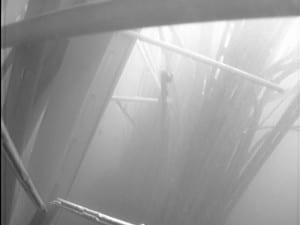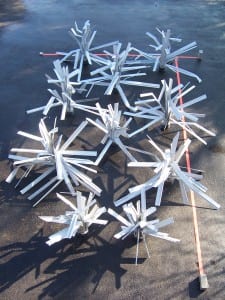Fish Habitat Award Winners Honored at Jim Range National Casting Call
THURSDAY, 21 APRIL 2011 15:08
(Washington, DC) – The winners of the National Fish Habitat Action Plan (NFHAP) Awards were honored for their extraordinary achievements at the Jim Range National Casting Call on Friday, April 15th on the grounds of the C&O Canal National Historic Park, along the banks of the Potomac River in Washington, DC.
Maureen Gallagher (Midwest National Fish Habitat Partnership Coordinator for the U.S. Fish and Wildlife Service), Mark Johnson (District Manager, Coos Bay District Office, BLM), Andy DuPont (Glen Lake Association), Dr. Stephen Brown (NOAA) were all recipients National Fish Habitat Awards for 2011.
This was the fourth year the NFHAP Awards have been handed out, recognizing outstanding achievements in Fish Habitat Conservation.
The NFHAP Award winners for 2011:
Maureen Gallagher, Midwest National Fish Habitat Partnership Coordinator for the U.S. Fish and Wildlife Service received the Jim Range Conservation Vision Award in support of Fish Habitat.
Award Presented by: Rowan Gould, Acting Director, U.S. Fish and Wildlife Service
Background:
Maureen Gallagher was instrumental in the recognition of five new Fish Habitat Partnerships. Maureen worked across Fish Habitat Partnership and US Fish and Wildlife Service regional boundaries, and developed a committee of Midwest state Fish Chiefs to weigh in on large scale National Fish Habitat Action Plan issues.
Through her vision and leadership, a Science Advisory Network was established including science expertise at all NFHAP levels. She worked with this group to fund and conduct basinwide assessments to help FHPs prioritize habitat efforts. This assessment effort was expanded to the Great Plains Fish Habitat Partnership.
On a national scale Maureen helped develop the National Fish Habitat Action Plan through participation on several committees to develop guidance and provide recommendations to the National Fish Habitat Board. She provides technical expertise in partnership building, fundraising and strategic planning to Fish Habitat Partnerships nationwide. Maureen is well known as an advocate and spokesperson for the Fish Habitat Partners and the National Fish Habitat Action Plan. Her thoughts and actions that relate to the Action Plan are always on target and in the long term interest of the success of this program to all involved.
Mark Johnson, District Manager for the Coos Bay District office for the Bureau of Land Management (BLM), accepted the award for Extraordinary Action in support of Fish Habitat Conservation Award.
Award Presented by: Tom Mendenhall, Senior National Fisheries Program Manager, Bureau of Land Management (BLM)
Background:
The Bureau of Land Management’s Coos Bay District Office (CBDO) has been in the forefront of efforts to restore habitat for native fish species on the southern Oregon coast over the past two decades. Numerous stream and riparian restoration projects at varying scales have been implemented by the CBDO over that time, but the scope and extent of the restoration work has increased substantially over the past 5 years as an outcome of developing partnerships with private landowners, watershed councils, and other state and federal agencies.
Dr. Dana Infante – Assistant Professor, Department of Fisheries and Wildlife, Michigan State University and Dr. Stephen Brown- Chief, Assessment and Monitoring Division (NOAA/NMFS), each accepted the award for Scientific Achievement in support of Fish Habitat Conservation on behalf of the National Assessment team for Michigan State University and NOAA, for their work on the National Status of fish habitats 2010 Report.
Award Presented by: Stan Moberly, past President, American Fisheries Society, National Fish Habitat Board
Background:
The NFHAP 2010 Assessment Team conducted an assessment of fish habitats in all 50 states at a scale and level of detail never before attempted. Their efforts included numerous steps, including: amending existing geospatial reference systems to their needs; searching out, collecting, and evaluating data sources; in some cases converting the data for their use: developing statistical methodologies; and seeking review of the assessment results.
Almost two dozen scientists from five academic and federal government institutions participated in the work, sharing ideas and solving problems in a true spirit of intellectual cooperation. The results of this team’s efforts have been used to publish the first comprehensive report, titled: Through A Fish’s Eye: The Status of Fish Habitats in the United States 2010 Report, on the status of fish habitat in the US, which will be used by aquatic habitat conservation policy-makers and practitioners to support and prioritize fish habitat conservation efforts.
The team has also laid the groundwork for recurring assessments to ascertain trends in fish habitat over time, which will help the National Fish Habitat Board determine where fish habitat conservation efforts are making a difference.
Andy DuPont, President, Glen Lake Association, accepted the Outreach and Educational Achievement Award in support of Fish Habitat Conservation.
Award Presented by: Kelly Hepler, National Fish Habitat Board Chairman
Background:
The Glen Lake Association is a grassroots organization of over 800 individual and business members. They work to protect and improve the Glen Lake watershed, which is recognized as an “interim priority watershed” in Midwest Glacial Lakes Partnership’s Strategic Plan. Through numerous outreach and education campaigns, the Glen Lake Association protects the Glen Lake watershed from aquatic invasive species, physical habitat degradation, and water quality impairment, while promoting aesthetic and recreational enjoyment by riparian owners and the public. The many programs that the Association implements serve many purposes including, providing high-quality status and trend data on the health of the aquatic ecosystem, and to engage and educate the community on the importance of long-term monitoring and the health of their local resources.
________________________________________
Award Winner Quotes:
Maureen Gallagher: “I am truly honored to accept such a prestigious award. Working with the National Fish Habitat Action Plan has been a rewarding experience for me both professionally and personally. Truly I accept this award on behalf of all of the partners involved in the Action Plan. Success stories through the Action Plan truly take a team effort.”
Mark Johnson: “The conservation work that has been done in the Coos Bay region of Oregon is nothing short of amazing. The Coos Bay staff of the BLM in all aspects is responsible for making a difference, by working in partnership with businesses and landowners to make a significant impact in Aquatic Conservation in Oregon.”
From Dr. Dana Infante: “The work that went into the assessment for the status report, took a great deal of effort to organize and compile. This would not have been possible if it weren’t for the great team that I have to work with at Michigan State University. We look forward to the challenge of completing the next assessment of our national waters.”
From Dr. Stephen Brown: “The NOAA assessment team really pulled a lot of critical information about our estuaries and coasts in a short amount of time for this report. Working in coordination with the Michigan State team took a lot of teamwork which resulted in a quality assessment of our national waters.”
The National Fish Habitat Awards presentation was just a portion of the program for the Jim Range National Casting Call. Other agencies represented for the Monday event included The American Fly Fishing Trade Association (AFFTA) and the Recreational Boating and Fishing Foundation (RBFF) and numerous other partners that help make the Jim Range National Casting Call a success every year.

